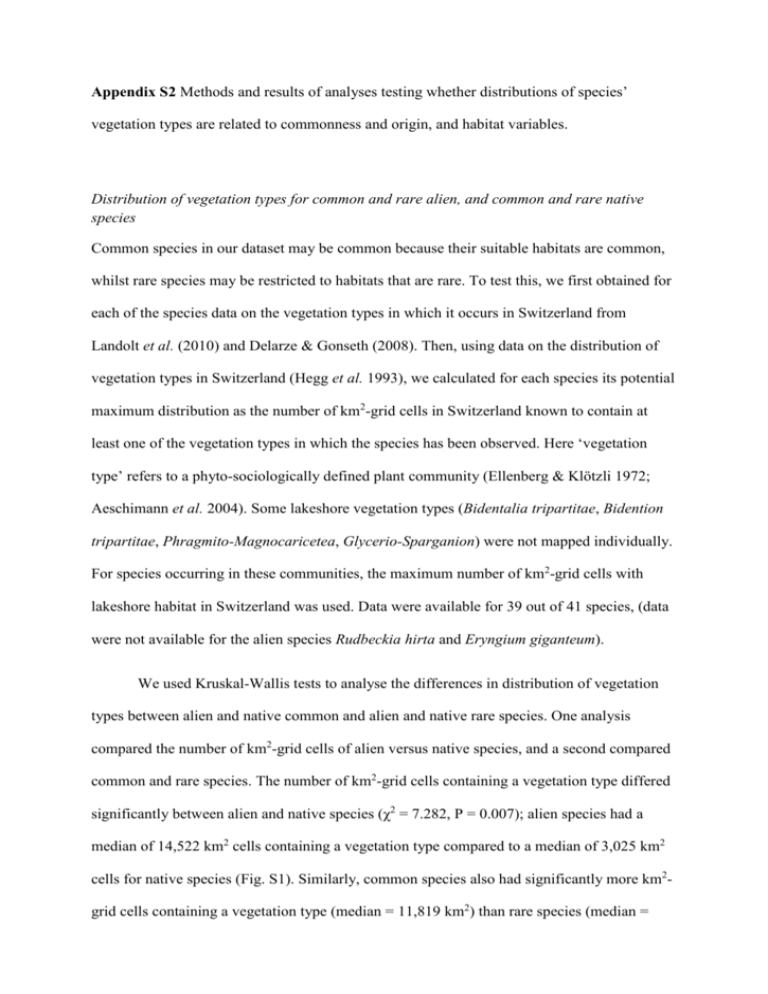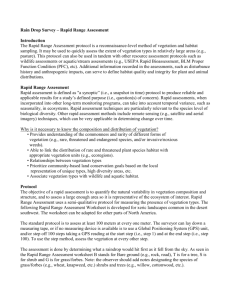ele1811-sup-0002-AppendixS2
advertisement

Appendix S2 Methods and results of analyses testing whether distributions of species’ vegetation types are related to commonness and origin, and habitat variables. Distribution of vegetation types for common and rare alien, and common and rare native species Common species in our dataset may be common because their suitable habitats are common, whilst rare species may be restricted to habitats that are rare. To test this, we first obtained for each of the species data on the vegetation types in which it occurs in Switzerland from Landolt et al. (2010) and Delarze & Gonseth (2008). Then, using data on the distribution of vegetation types in Switzerland (Hegg et al. 1993), we calculated for each species its potential maximum distribution as the number of km2-grid cells in Switzerland known to contain at least one of the vegetation types in which the species has been observed. Here ‘vegetation type’ refers to a phyto-sociologically defined plant community (Ellenberg & Klötzli 1972; Aeschimann et al. 2004). Some lakeshore vegetation types (Bidentalia tripartitae, Bidention tripartitae, Phragmito-Magnocaricetea, Glycerio-Sparganion) were not mapped individually. For species occurring in these communities, the maximum number of km2-grid cells with lakeshore habitat in Switzerland was used. Data were available for 39 out of 41 species, (data were not available for the alien species Rudbeckia hirta and Eryngium giganteum). We used Kruskal-Wallis tests to analyse the differences in distribution of vegetation types between alien and native common and alien and native rare species. One analysis compared the number of km2-grid cells of alien versus native species, and a second compared common and rare species. The number of km2-grid cells containing a vegetation type differed significantly between alien and native species (χ2 = 7.282, P = 0.007); alien species had a median of 14,522 km2 cells containing a vegetation type compared to a median of 3,025 km2 cells for native species (Fig. S1). Similarly, common species also had significantly more km2grid cells containing a vegetation type (median = 11,819 km2) than rare species (median = 3,025 km2; χ2 = 6.938, P = 0.008; Fig. 1). Thus, common and alien species occur in vegetation types that are more widespread than the vegetation types containing rare and native species, respectively Fig. S1 The number of km2-grid cells in Switzerland containing at least one vegetation type for species which are alien and common, alien and rare, native and common and native and rare in Switzerland (n=39). Bold line indicates median number of km2-grid cells per group; box represents 25%-75% interquartile range; whiskers encompass 1.5 times the interquartile range. Distribution of vegetation types in relation to habitat variation and environmental indices Differences in habitat associations and environmental conditions among species may result in more widespread habitats being available for some species compared to other species with differing requirements. To assess whether species habitat differences were associated with distribution of vegetation types (i.e. whether certain environmental conditions are more common), we used Kendall’s tau correlation on the number of km2-grid cells containing at least one vegetation type per species and the environmental variable indices. We also used Kendall’s tau correlation to test the association between the distribution of vegetation types per species and the NMDS axes describing habitats. The number of km2-grid cells in Switzerland containing at least one vegetation type per species was positively associated with the soil nutrient and hemeroby indices, but was not significantly associated with any of the other environmental indices (Table S1). The three NMDS axes were not significantly correlated with the distribution of vegetation types (Table S1). Therefore, whilst species occurring in nutrient-rich, human-modified habitats may have more widespread vegetation types, habitat dissimilarity of species overall did not appear to be strongly related to the potential distribution of species. In other words, it is unlikely that in our study habitat dissimilarity resulted in common species occurring in more widespread vegetation types than rare species). Table S1. Kendall’s tau correlation coefficients for relationships between the number of km2grid cells in Switzerland containing at least one vegetation type per species, values from the Flora Indicativa, and the NMDS axes 1-3 for the 39 species with available data. No. km2-grid cells containing at least one vegetation type NMDS1 0.048 ns NMDS2 0.189 ns NMDS3 -0.210 ns Temperature -0.029 ns Soil nutrients 0.302 * Light -0.129 ns Soil moisture -0.164 ns Hemeroby 0.312 * ReferencesAeschimann, D., Lauber, K., Moser, D.M. & Theurillat, J-P. (2004). Flora Alpina. Haupt Verlag, Bern, Switzerland. Delarze, R. & Gonseth, Y. (2008) Lebensraüme der Schweiz: Ökologie-GefährdungKennarten. 2nd edition. Ott-Verlag, Bern, Switzerland. Ellenberg, H. & Klötzli, F. (1972). Waldgesellschaften und Waldstandorte der Schweiz. Mitteilungen der Schweizerischen Anstalt für das forstliche Versuchswesen, 48, 589930.Hegg, O., Bequin, C. & Zoller, H. (1993) Atlas Schutzwürdiger Vegetationstypen der Schweiz. Bundesamt für Umwelt, Wald und Landschaft (BUWAL) und Eidgenossenchaft Drucksachen- und Materialsentrale (EDMZ), Bern, Swizterland. Landolt, E. et al. (2010) Flora Indicativa. Ecological Indicator Values and Biological Attributes of the Flora of Switzerland and the Alps. Haupt Verlag, Bern, Switzerland.








